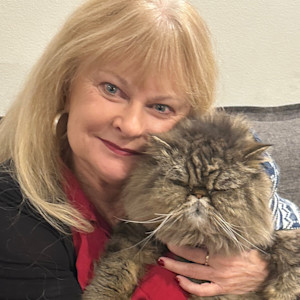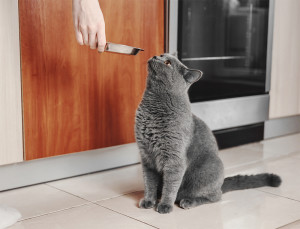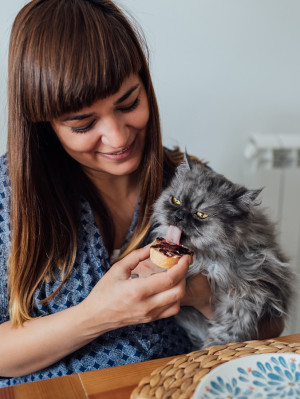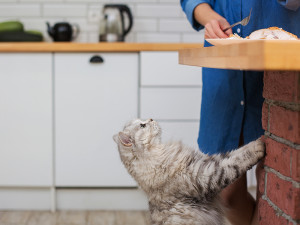Do Cats Need Wet Food? Find Out if It’s Best for Them or Not
We outline everything you need to know about wet vs. dry cat food and more.

Share Article
In This Article:
What Are the Main Differences Between Wet and Dry Cat Food? Is Wet Food or Dry Food Better for Your Cat? What Wet and Dry Cat Foods Do Veterinarians Recommend? Frequently Asked Questions
Cats are obligate carnivores, meaning they must eat primarily animal protein. They cannot digest plant material. For example, a common belief is that if your cat goes outdoors and eats grass, then vomits, they ate it because they needed to vomit. It’s just the opposite. If your cat vomits after eating grass, it’s because they cannot digest grass or any other plant material well.
What does this have to do with wet versus dry cat food? You’ll see when you read about canned food and kibble content. Once you discover the differences in the ingredients, you may no longer ask yourself which food you should feed your kitty. We will help you make an informed decision that will ensure the best health possible for your feline companion.
What are the main differences between wet and dry cat food?
There are a few differences between canned and dry cat food. We’ll discuss the most important ones, but the most significant is the amount of water in each.

Moisture levels
One of the most noticeable differences between wet and dry cat food is their moisture content. The water content in canned food is much higher than that of dry food. Wet food can have as much as 80 percent water content, while dry food averages around 10 percent.
Wet food: The moisture in canned cat food keeps your kitty well-hydrated, which is very important, especially for cats. If they eat exclusively canned food, they consume a lot more water, which is very important for urinary tract health, including kidney issues common in cats.
Dry food: Because dry food has so little moisture, cats must drink enough water to stay hydrated. On the flip side, dry food is convenient. If your cat drinks a lot, dry food may be fine.
Manufacturing process
The manufacturing process of wet and dry cat food is another key difference.
Wet food: The production process involves mixing a stew or pate, which is then sealed and cooked in cans or pouches. This process retains moisture and has a softer texture, often more appealing to finicky or sick cats.
Dry food: Kibble is made by combining ingredients into a dough that is then baked into dry food. This process removes almost all the moisture. Most pet lovers like dry food's easy storage and longer shelf life. Also, many believe feeding your cat dry food keeps their teeth clean. More about that below.
Nutrients
The nutrient profile varies greatly depending on the ingredients and the brand.
Wet food: The ideal cat diet should mimic what a cat eats in the wild, and wet food does that. High protein, moderate fat, and low carbohydrates are ideal. This concept was not considered for decades, but fortunately, trends have changed, and more brands have adopted this formula, leading to better overall health.
Dry food: Kibble often contains more carbohydrates and fillers than a cat needs. Recently, brands of dry food have emerged that are better suited to a proper cat diet but are more expensive. Consequently, the trend is still to produce dry cat food that is too high in carbohydrates.
Is wet food or dry food better for your cat? Can they eat both?
There are benefits of both dry and wet cat food, but you have to weigh the importance of the benefits. For example, you may think it’s great that dry food can be left out without spoiling, but is it more important that dry cat food be left out or that canned food can keep your cat well-hydrated and support the urinary tract? Let’s go over the main benefits of both types of cat food.
Benefits of wet cat food
Canned cat food has much more moisture, which helps support the urinary tract.
Most cats do not drink enough, and the extra water in canned food supports better health in general.
Canned cat food is lower in calories than dry food per serving and can help overweight cats trim down.
Canned food is often tastier than dry food, which can help encourage picky cats.
Canned cat food is easier to eat for cats with dental issues.
If your cat has digestion issues, canned food can be easier to eat.
Benefits of dry cat food
As mentioned, dry food is easier to store and less likely to spoil.
Dental health may be improved if a cat eats only dry food, although that is not the best way to take care of your cat’s teeth.
Dry food is generally less expensive than canned.
Dry cat food can be used in puzzle feeders, which is good for mental stimulation and training.
Can they eat both?
Cats can eat both dry and wet food, but that doesn’t mean it’s best for them. It’s a popular approach, mainly for the following reasons:
Dry cat food is more convenient.
Dry food may help with dental disease.
Dry food is less expensive.
Wet food provides far more moisture.
Canned cat food is lower in carbohydrates.
However, you must weigh the importance of those features and decide if a feature you like is also healthy.
What wet and dry cat food do veterinarians recommend?
Not every veterinarian suggests the same diet, but most recommend high-quality, well-balanced brands that meet Association of American Feed Control Officials (AAFCO) standards. Some popular recommendations include Hill’s Science Diet, Royal Canin, Purina Pro Plan, Orijen, Acana, and Wellness CORE. Many of these brands offer options for weight management, urinary health, and sensitive stomachs.
When choosing a brand, consult your veterinarian to ensure the food meets your cat’s dietary requirements. Age, weight, health conditions, and activity level should all be considered when selecting a diet.
FAQs
Is it OK not to feed my cat wet food?
It is best to feed all canned food or at least some canned food. Dry food is almost always too high in carbohydrates and too low in moisture, which has been associated with a higher risk of diabetes, excess weight, and dehydration, which can lead to urinary issues.
Is it OK to feed cats dry food only?
It is generally not okay to feed only dry cat food. This can lead to a high percentage of carbohydrates in the diet, which in turn can lead to problems such as diabetes and obesity. The exception would be choosing a brand of dry cat food low in carbohydrates. There are not many of them. Even if you select one, an exclusively dry diet also has too little moisture, which can lead to urinary problems and dehydration in general.
How can I transition between wet and dry food?
If you have been feeding your cat dry food exclusively and want to switch to canned or partially canned, it’s not as simple as just taking up the bowl of dry food and putting down the canned. It must be done gradually, or your kitty may develop digestive upsets. It should take seven to 10 days to make the switch. Begin by adding a bit of canned food to your cat’s dry food and gradually increase the amount until you are feeding canned only.
Tips for a smooth transition:
Monitor your cat closely as you make this change. If you see any signs of digestive upset, such as vomiting or diarrhea, you may need to back up and make the change more slowly.
If your cat is reluctant to eat the canned food, try different flavors and textures. Some cats like the grilled variety but refuse to touch the pate version of the same food.
Be patient. Cats can be hesitant to make changes about anything, including their diet.
Create routines. Feed at the same location at the same time to establish a sense of familiarity.
Use positive reinforcement. When your cat eats the new food, offer praise and a treat.
If your cat has a medical condition such as diabetes or kidney disease, consult your veterinarian about the food you should feed.
If your cat is particularly attached to dry food and will not eat canned cat food, always have fresh water available. Try a pet fountain. Most cats like moving water and will drink more if there’s a fountain available.
References
Conor O’Halloran, et al. “How and Why Pet Cats Are Fed the Way They Are: A Self-Reported Owner Survey.” Journal of Feline Medicine and Surgery, vol. 26, no. 2, 1 Feb. 2024, https://doi.org/10.1177/1098612x231209894opens in new tab.
Cornell University College of Veterinary Medicine. “Hydration.” Cornell University College of Veterinary Medicine, 8 July 2021, www.vet.cornell.edu/departments-centers-and-institutes/cornell-feline-health-center/health-information/feline-health-topics/hydrationopens in new tab.
Thomas, D. G., et al. “The Effect of Changing the Moisture Levels of Dry Extruded and Wet Canned Diets on Physical Activity in Cats.” Journal of Nutritional Science, vol. 6, 2017, https://doi.org/10.1017/jns.2017.9opens in new tab.

Dr. Shelby Neely, DVM
Dr. Shelby Neely is a freelance writer and veterinarian who graduated from the University of Pennsylvania School of Veterinary Medicine and has practiced veterinary medicine for 30 years, specializing in small animals. Her work has appeared in Allivet, AsktheCatDoctor, WhiskerDocs, Ask the Cat Doctor Radio, Ask the Cat Doctor TV, and numerous other websites, brochures, newsletters, newspapers, and ebooks. In her spare time, Dr. Neely likes to spend time with her three children, two grandchildren, three cats, two grand-cats, and five grand-dogs.
Related articles
![Hand holding food bowl peeks into frame as a cat looks up expectantly]()
The Ultimate Puzzle: Picking the Right Cat Food
Four veterinary nutritionists pick apart the claims so that you can choose the right food for your kitty.
![Woman feeding her puffy cat at the table.]()
What Human Foods Can Cats Eat?
We know they’re begging—but what’s safe to share?
Can a Kitten Eat Adult Cat Food?
Uhh, is that safe, little guy?
![Cat asking for human food from counter]()
What Can Cats Eat Besides Cat Food?
Good news for your begging cat: Some of your favorite snacks are safe to share.
How Long Can Wet Cat Food Sit Out?
Your new cat certainly isn’t going to have the answer.
![A woman feeding food to her cat at a dining room table]()
Is Homemade Cat Food Good for Your Kitty?
The best ingredients to include when considering a home-cooked diet for your cat.






